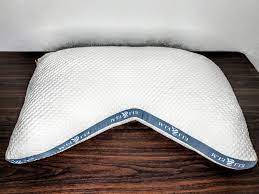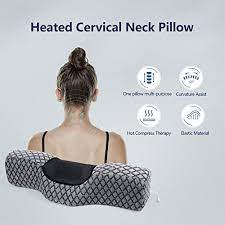

If you have ever emerged from a TikTok spiral or a Netflix binge with your neck feeling like it is auditioning for a role in a horror movie—stiff, twisted, and full of regret—congratulations, you’ve met “text neck.”
This charmingly modern condition stems from too much time looking down at our screens, and it is fast becoming the badge of the digital age.
But here is the twist: while fixing your daytime posture matters, what you do while you sleep can either heal or hurt your neck even more.
That is right—your pillow might be the sneaky culprit behind your morning aches, or your secret weapon against them.
Choosing the right one can be the difference between waking up feeling like royalty or like you have wrestled with your smartphone in your sleep.
In this guide, BestForwardHeadPostureFix researchers shall break down how to pick the perfect pillow to fight off text neck, so you can finally stop snoozing your way into spinal misery.
Points Covered in this Article
- Understanding Text Neck and Its Implications
- The Role of Pillows in Neck Health
- Key Features to Look for in a Pillow
- Top Pillow Types for Text Neck Relief
- Adjusting Your Sleep Environment
- Additional Tips for Neck Health
- Takeaway
Understanding Text Neck and Its Implications
“Text neck” isn’t just a buzzword—it’s a real, posture-wrecking condition born from our collective love affair with laptop screens.
It refers to the strain that builds up in the neck and upper spine when we spend hours with our heads tilted forward, usually scrolling, typing, or binging TV shows.
This position might feel harmless in the moment, but over time, it wreaks havoc.
Chronic neck pain is the most obvious result, often starting as a dull ache and evolving into persistent discomfort.
Reduced mobility is another red flag—turning your head should not feel like a rusty hinge.
Then come the tension headaches, particularly chronic-type ones, caused by overstretched neck muscles and poor blood flow.
And let us not forget shoulder tension, where tightness creeps in like an uninvited guest.
The fix?
It takes a combo of better ergonomics, movement, and—surprisingly—your pillow.
A well-chosen pillow can help correct alignment while you sleep, giving your neck a much-needed break from modern life.
The Role of Pillows in Neck Health
While we often obsess over sitting up straight at our desks or adjusting our phone angles during the day, we tend to forget that our neck posture during sleep—an activity that takes up nearly a third of our lives—is just as important.
Nighttime alignment is your body’s prime time for recovery. During sleep, spinal tissues decompress, muscles relax, and cellular repair kicks into high gear.
But here is the catch: if your neck is bent at an awkward angle because of a flat, overstuffed, or lumpy pillow, you are essentially sabotaging your healing time.
A supportive pillow is like a nighttime chiropractor—cradling the neck in its natural curve and helping your spine stay neutral.
For instance, a cervical pillow can prevent your head from tilting too far forward, a common issue for back sleepers. Side sleepers may benefit from a firmer, higher pillow to bridge the gap between shoulder and ear.
On the flip side, using the wrong pillow—say, one that’s too thick or too soft—can hyperextend your neck, putting pressure on nerves and discs.
This can lead to more than just discomfort; it can cause headaches, numbness, and poor sleep quality.
So yes, your pillow could be silently making your neck worse—or better.
Choose wisely.
Key Features to Look for in a Pillow
When choosing a pillow to help fix text neck, focus on these four key features—each plays a vital role in maintaining healthy neck alignment during sleep:
Support:
A good pillow should maintain the natural curve of your neck. It must provide consistent support throughout the night, preventing your head from tilting too far forward or backward.
Whether you sleep on your back or side, proper support ensures your cervical spine stays in a neutral position.
Adjustability:
Everyone’s anatomy is different. Look for pillows with adjustable lofts (height) or customizable inserts. This lets you tailor the pillow’s firmness and elevation to your personal comfort, which is especially helpful if your needs change due to pain, injury, or sleeping position.
Material:
Opt for materials like memory foam or latex. These contour to your neck and head shape, offering targeted pressure relief and stability.
They are also more durable and maintain their structure better than traditional fiberfill options.
Breathability:
A breathable pillow helps regulate heat and moisture. Look for models with ventilated foam, cooling gels, or moisture-wicking covers.
Overheating can disrupt sleep, and restless tossing can worsen neck misalignment, so breathability indirectly supports posture correction.
Top Pillow Types for Text Neck Relief
When it comes to correcting text neck, not all pillows are created equal. Choosing the right type can make a remarkable difference in how your neck feels by morning.
Here are four top contenders:
Memory Foam Pillows:
Memory foam is a favorite for a reason. It molds to the unique contours of your head and neck, offering personalized support that keeps your spine in optimal alignment.
Its pressure-relieving properties help reduce strain on overstressed muscles, making it ideal for those with text neck symptoms.
Cervical Pillows:
These are orthopedic pillows with a special ergonomic design—often featuring a dip in the center to cradle the head and raised edges to support the neck curve. They’re perfect for chronic neck pain sufferers, offering structure where standard pillows fall flat—literally.
Water-Based Pillows:
Want total control? Water pillows let you adjust firmness by adding or removing water. They adapt naturally to movement during the night, maintaining consistent support. This dynamic flexibility can help keep your neck in a safe, neutral position all night.
Latex Pillows:
Latex offers the best of both worlds—firmness and bounce, with natural contouring. These pillows are resistant to sagging and provide breathable, long-lasting support, making them a great choice for hot sleepers who still want spinal alignment.
Adjusting Your Sleep Environment
Here is how to optimize your sleep environment beyond just picking the right pillow:
Mattress Compatibility:
Your mattress and pillow should work in harmony to support spinal alignment. A mattress that’s too soft can cause your body to sink unevenly, misaligning your spine and nullifying the benefits of a good pillow. Choose a medium-firm mattress that provides even support across your body.
Sleep Position:
Your sleeping posture matters. Back sleeping is ideal for evenly distributing weight and keeping your head aligned with your spine. Side sleeping is also effective, but make sure your pillow fills the space between your head and shoulder. Avoid sleeping on your stomach—it forces your neck into an awkward twist for hours at a time.
Pillow Placement:
Don’t just toss your pillow under your head. Make sure it also supports the curve of your neck. A pillow placed too high can bend your neck forward, while one too low can let it sag backward—both of which contribute to neck strain. Proper placement promotes natural alignment and reduces morning stiffness.
FAQs on Right Pillow for Fixing Nerd Neck Posture
Q-1: How do I pick pillow height to restore the neck’s natural curve?
A-1: Match loft to your sleep position and shoulder width. For side sleepers, measure ear-to-shoulder while seated tall; choose a pillow close to that number so the nose lines up with the sternum.
For back sleepers, aim lower—just enough to fill the space under the neck without pushing the chin to the chest.
Stomach sleeping?
Use the thinnest pillow or none, plus a small chest wedge to keep the neck neutral.
Q-2: Does a contoured “cervical” shape actually help text neck—or is it hype?
A-2: It can help when the contour fits. The higher edge supports the neck while the recess cradles the head, reducing flexion from tech use.
Quick fit check: lying supine, you should feel gentle contact along the neck with the jaw level, not tilted up.
If you feel pressure at the skull base or your chin lifts, the contour is too tall.
Q-3: Memory foam, latex, feather, or adjustable fill—which material eases morning stiffness best?
A-3: For most, responsive foams (latex or slower-memory foam) keep shape overnight and limit “sink” that rounds the neck forward. If your stiffness varies, pick adjustable shredded foam or microfibre so you can add/remove fill.
Feather/down can work if you pack firm under the neck and keep the head area softer—but expect frequent reshaping.
Q-4: I switch positions at night—what design prevents a 3 a.m. neck crank?
A-4: Choose a dual-height or adjustable pillow: higher edge for side, lower center for back.
Mark the higher edge toward the shoulder so you land correctly when rolling. If you often read in bed, use a separate wedge for propping; don’t overstuff your sleep pillow for reading, or you’ll force flexion once you drift off.
Q-5: How can I tell in 60 seconds if a pillow is helping my “text neck”?
A-5: Do the chin-poke test. Lie as you sleep, breathe out, then try to nod “yes.” If nodding is easy without the chin jutting, alignment is close.
If your chin wants to slide forward or your throat feels compressed, reduce loft; if your head falls backward and the neck floats, add loft or a slim cervical roll under the pillowcase.
Q-6: What buying and care details matter for long-term relief?
A-6: Prioritize trial windows (2–4 weeks), removable layers or fill, and a breathable cover (cotton/bamboo) to minimize heat-tension wake-ups.
Replace every 18–36 months (or when it pancakes). Pair the pillow with a neutral-screen habit: read at eye level for 10 minutes before bed, then do five slow neck stretches—your pillow holds the curve you practice.
Additional Tips for Neck Health
Here are a few ways and means to ensure that your neck retains its natural shape and position:
Limit Screen Time:
Reduce prolonged periods on phones, tablets, and laptops. Follow the 20-20-20 rule—every 20 minutes, look at something 20 feet away for 20 seconds—to relieve eye and neck strain. Schedule regular breaks to reset your posture and avoid cumulative stress on your cervical spine.
Self Posture Checks:
Be consciously aware of how you are holding your head throughout the day. Your ears should align with your shoulders—not jutting forward. Use sticky notes, phone alarms, or posture-monitoring apps to remind yourself to correct your form regularly.
Regular Exercise:
Strengthen key muscle groups like your deep neck flexors, upper traps, and shoulder stabilizers. Incorporate exercises such as chin tucks, shoulder blade squeezes, and rows to support proper head and neck alignment.
Stay Hydrated:
Spinal discs need water to maintain their height and function as shock absorbers. Dehydration can lead to stiff, less resilient discs—contributing to neck discomfort. Aim for 8–10 cups of water daily, especially if you are physically active or work in dry environments.
My Conclusive Analysis
Text neck is no longer a passing discomfort—it is a chronic strain fueled by our digital habits. But recovery starts in the most overlooked place: your sleep setup.
Investing in the best neck brace for forward head posture would not help much if your pillow fails to support proper alignment. That is why selecting a smart posture corrector for neck alignment during the day and a quality pillow at night can work hand in hand.
Whether you prefer the cervical traction device benefits of contouring pillows or are just learning how to fix tech neck with devices, the foundation is the same: alignment matters.
From posture corrector braces for neck and shoulders to neck alignment exercises with devices, consistency is key.
And when it comes to forward head posture correction tools, do not underestimate the quiet power of your pillow—it could be your most restful remedy.
References:

